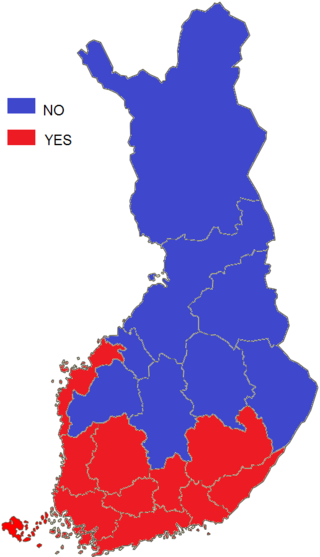
Folketing elections were held in Denmark on 3 April 1939, except in the Faroe Islands where they were held on 19 April. They followed a dissolution of both chambers in order to call a referendum on changing the constitution. The referendum was held on 23 May but failed due to a low voter turnout. The result of the elections was a victory for the Social Democratic Party, which won 64 of the 149 seats. Voter turnout was 79.2% in Denmark proper and 47.8% in the Faroes.

A referendum on the enlargement of the European Communities (EC) was held in France on 23 April 1972. Voters were asked whether they approved of Denmark, Ireland, Norway and the United Kingdom joining the EC, although Norway later voted in its own referendum not to join. The proposals were approved by 68.3% of voters, with a turnout of 60.2%.

A referendum to approve the Évian Accords ending the Algerian War and granting self-determination to Algeria was held in France on 8 April 1962. It was approved by 90.8% of voters with a 75.3% turnout.

A referendum on re-establishing the Empire was held in France on 21 and 22 November 1852. Voters were asked whether they approved of the re-establishment of the Empire in the person of Louis Napoléon Bonaparte and family. It was approved by 96.9% of voters with a 79.8% turnout.
A referendum on lowering the voting age from 20 to 18 was held in Denmark on 19 September 1978. It was held after the Danish government lowering the age of majority from 20 to 18 in 1976. The change was approved by 53.8% of voters with a turnout of 63.2%. The electoral age had previously been lowered from 21 to 20 in a 1971 referendum, after a 1969 referendum had rejected lowering the electoral age to 18.
A referendum on lowering the voting age from 21 to 20 was held in Denmark on 21 September 1971. The change was approved by 56.5% of voters, with a turnout of 86.2%. A previous referendum had been unsuccessful in lowering the electoral age to 18 years, which was introduced after a 1978 referendum and which still stands.
A referendum on lowering the voting age from 21 to 18 was held in Denmark on 24 June 1969. The proposed change was rejected by 78.6% of voters with a turnout of 63.6%. Two years later, the electoral age was instead lowered to 20 years, and finally, after a 1978 referendum, to 18 years.
A referendum on reducing the voting age from 23 to 21 was held in Denmark on 30 May 1961. It was approved by 55% of voters with a 37.3% turnout.

A constitutional referendum was held in Poland on 25 May 1997. Voters were asked whether they approved of a new constitution. It was narrowly approved, with 53.5% voting in favour. Voter turnout was just 42.9%. Although the 1995 Referendum Act stated that a 50% turnout was required to validate the referendum, the Supreme Court ruled on 15 July that the constitution could be introduced.
A referendum on restoring voluntary religious education to state schools was held in Estonia between 17 and 19 February 1923. It was approved by 71.9% of voters with a turnout of 66.2%.
A constitutional referendum was held in Estonia between 14 and 16 October 1933. After two new constitutional drafts proposed by Parliament had been rejected by referendums in 1932 and June 1933, a third draft proposed by the radical right-wing Movement of Veterans of the War of Independence was approved by 72.7% of voters, with a turnout of 77.9%.
An independence referendum was held in the Estonian SSR on 3 March 1991, alongside a similar referendum in the Latvian SSR the same day. It was approved by 78.4% of voters with an 82.9% turnout. Independence was restored by the Estonian Supreme Council on the night of 20 August.

An advisory referendum on joining the European Union was held in Finland on 16 October 1994. 56.9% of voters approved of the proposal, with a voter turnout of 70.8%. Due to having its own customs jurisdiction, a separate referendum was held in Åland a month later, and was also approved.
A referendum on introducing direct elections for the Presidency was held in Hungary on 29 July 1990. Although the proposal was supported by 85.9% of voters, turnout was just 14%, resulting in the referendum being declared invalid. As a result, the President continued to be elected by the National Assembly.

An abrogative referendum on the electoral law was held in Italy on 9 June 1991. Voters were asked whether the clause of the law on the number of preference votes should be scrapped. The result was 95.6% in favour, with a turnout of 65.1%.

A four-part abrogative referendum on fertility laws was held in Italy on 12 June 2005. Voters were asked whether research and access to the research on embryos should be limited, whether embryos should be legally recognised as people and whether IVF treatment should be limited to three embryos. The referendum was called after the Italian Radicals collected the 500,000 signatures required. Although all four proposals were approved by wide margins, the voter turnout of 26% was well below the 50% threshold and the results were invalidated. Pope Benedict XVI had called for a boycott.

An independence referendum was held in the Latvian SSR on 3 March 1991, alongside a similar referendum in the Estonian SSR the same day. Known as the "Popular Survey about the independence of the Republic of Latvia", voters were asked "are you in favour of a democratic and independent Republic of Latvia". It was approved by 74.9% of voters, with a turnout of 87.6%. Latvian Republic civilians registered in Soviet Army units also had the right to vote in this poll.
A referendum on the retrospective disclosure of the financial details of large-scale privatisation was held in Slovakia on 22 October 1994. Although approved by 95.9% of those voting, voter turnout was just 20% and the referendum was declared invalid due to insufficient turnout.
A referendum on banning the privatisation of strategically important state-owned companies was held in Slovakia on 25 and 26 September 1998. Although approved by 84.3% of those voting, voter turnout was just 44.1% and the referendum was declared invalid due to insufficient turnout.
A referendum on holding early parliamentary elections was held in Slovakia on 11 November 2000. Although approved by 95.1% of those voting, voter turnout was just 20% and the referendum was declared invalid due to insufficient turnout.






